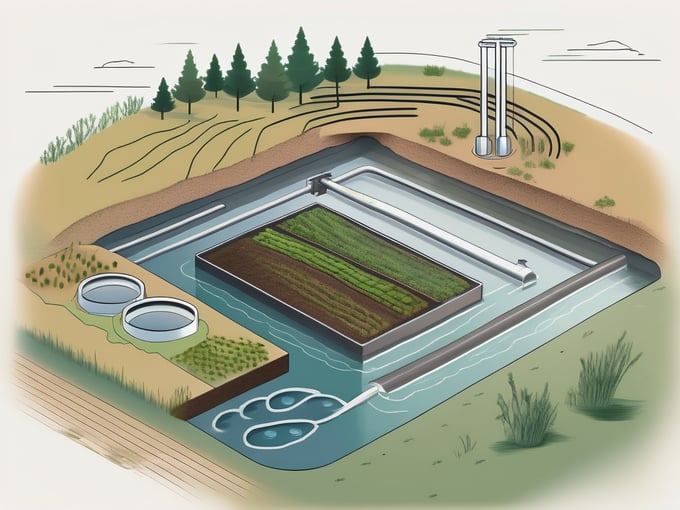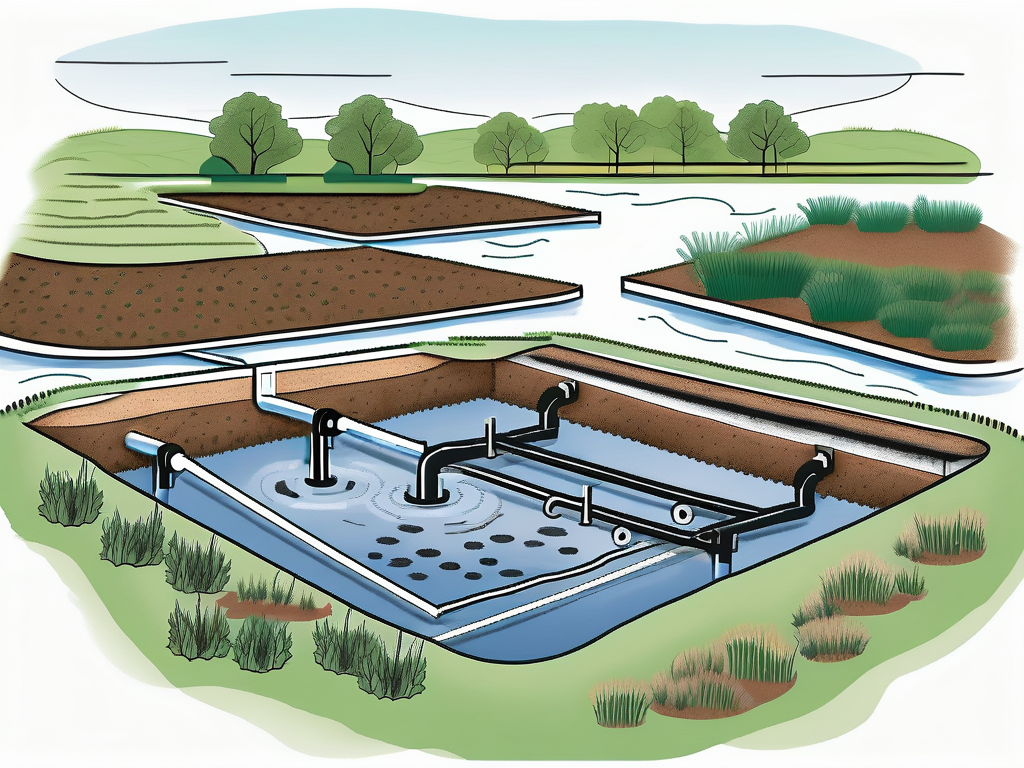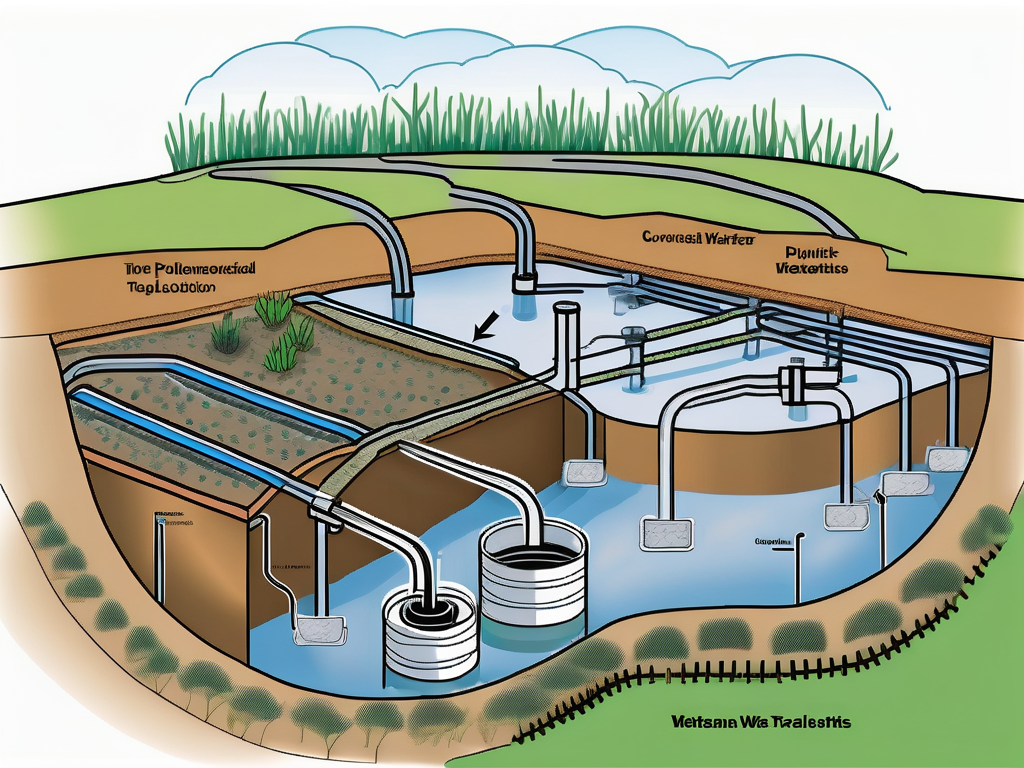
Decentralized Wastewater Treatment: Wastewater Treatment Explained
Wastewater treatment is a critical process that ensures the health and safety of communities and the environment. It involves the removal of contaminants from wastewater, primarily from household sewage, to produce an effluent that can be safely returned to the environment or reused. Decentralized wastewater treatment, a specific type of wastewater treatment, is an approach that treats wastewater at or near its source, rather than collecting and transporting it to a centralized treatment plant. This article delves into the intricacies of decentralized wastewater treatment, providing a comprehensive understanding of its principles, processes, advantages, and challenges.
Decentralized wastewater treatment systems (DWTS) are gaining popularity due to their cost-effectiveness, sustainability, and adaptability to varying conditions. They are particularly beneficial in rural and remote areas where centralized wastewater treatment facilities may not be feasible due to geographical, financial, or infrastructural constraints. This glossary article aims to provide an in-depth understanding of decentralized wastewater treatment, its components, and its role in sustainable wastewater management.
Principles of Decentralized Wastewater Treatment
The fundamental principle of decentralized wastewater treatment is the localized treatment of wastewater. This means that the wastewater generated in a particular area is treated within or near that area, reducing the need for extensive sewer networks and pumping stations. This localized approach not only reduces the cost and energy associated with wastewater transportation but also allows for the treatment process to be tailored to the specific characteristics of the wastewater being treated.
Another key principle of decentralized wastewater treatment is resource recovery. Many decentralized systems are designed to recover valuable resources from wastewater, such as water for irrigation, nutrients for agriculture, and energy in the form of biogas. This resource recovery aspect not only makes decentralized systems more sustainable but also contributes to their economic viability.
Localized Treatment
The concept of localized treatment is central to decentralized wastewater treatment. Instead of collecting wastewater from a large area and transporting it to a centralized treatment plant, decentralized systems treat wastewater at or near its source. This could be at the level of a single building, a cluster of buildings, or a small community. The localized treatment approach reduces the need for extensive sewer networks and pumping stations, which can be expensive to install and maintain, particularly in rural and remote areas.
Localized treatment also allows for the treatment process to be tailored to the specific characteristics of the wastewater being treated. For example, wastewater from a residential area may have different characteristics than wastewater from an industrial area, and therefore may require different treatment processes. By treating wastewater at its source, decentralized systems can be designed to effectively treat the specific type of wastewater they are dealing with.
Resource Recovery
Resource recovery is another key principle of decentralized wastewater treatment. Many decentralized systems are designed to recover valuable resources from wastewater, such as water for irrigation, nutrients for agriculture, and energy in the form of biogas. This resource recovery aspect not only makes decentralized systems more sustainable, but also contributes to their economic viability.
For example, the treated water from a decentralized system can be used for irrigation or other non-potable uses, reducing the demand for freshwater. Similarly, the nutrients recovered from wastewater can be used as fertilizer in agriculture, reducing the need for synthetic fertilizers. In some cases, the organic matter in wastewater can be converted into biogas, a renewable source of energy. These resource recovery aspects not only make decentralized systems more sustainable, but also contribute to their economic viability.
Components of Decentralized Wastewater Treatment Systems
A decentralized wastewater treatment system typically consists of several components, each performing a specific function in the treatment process. These components may include a septic tank for preliminary treatment, a secondary treatment unit for further treatment, and a dispersal system for returning the treated effluent to the environment. The specific components and their arrangement can vary depending on the specific requirements of the system.

It's important to note that the design and operation of a decentralized system require a thorough understanding of the local conditions, including the characteristics of the wastewater, the local climate, the soil conditions, and the intended use of the treated effluent. This understanding allows for the system to be designed and operated in a way that ensures effective treatment and safe disposal or reuse of the treated effluent.
Septic Tank
A septic tank is a common component of decentralized wastewater treatment systems. It is a watertight container made of concrete, fiberglass, or plastic, which provides preliminary treatment of the wastewater. The septic tank works by allowing the solids in the wastewater to settle to the bottom, forming a sludge layer, while the fats and oils float to the top, forming a scum layer. The liquid in the middle, known as the effluent, is then discharged to the next treatment stage.
The sludge and scum layers are retained in the tank and are broken down by anaerobic bacteria over time. However, these layers gradually build up and need to be periodically removed by pumping out the tank. The frequency of pumping depends on the size of the tank, the amount of wastewater being treated, and the amount of solids in the wastewater.
Secondary Treatment Unit
The effluent from the septic tank is typically not sufficiently treated to be safely discharged to the environment. Therefore, it is often sent to a secondary treatment unit for further treatment. The specific type of secondary treatment unit can vary depending on the requirements of the system. Some common types of secondary treatment units used in decentralized systems include sand filters, peat filters, and aerobic treatment units.
Sand filters use a bed of sand to filter out additional solids and bacteria from the effluent. Peat filters use a bed of peat moss for the same purpose. Aerobic treatment units use oxygen and bacteria to break down the organic matter in the effluent. The choice of secondary treatment unit depends on the specific requirements of the system, including the desired level of treatment, the available space, and the local regulations.
Dispersal System
The final component of a decentralized wastewater treatment system is the dispersal system, which returns the treated effluent to the environment. The specific type of dispersal system can vary depending on the local conditions and the intended use of the treated effluent. Some common types of dispersal systems include leach fields, drip irrigation systems, and evapotranspiration systems.
A leach field is a series of perforated pipes buried in a field of gravel. The treated effluent is discharged into the leach field, where it percolates through the gravel and into the soil, where further treatment occurs. A drip irrigation system disperses the treated effluent over a large area, where it is absorbed by the soil and used by plants. An evapotranspiration system uses the sun's energy to evaporate the treated effluent, returning it to the atmosphere as water vapor.
Advantages of Decentralized Wastewater Treatment
Decentralized wastewater treatment has several advantages over centralized treatment, particularly in rural and remote areas. These advantages include lower cost, greater flexibility, and the potential for resource recovery.

The cost of installing and operating a decentralized system is often lower than that of a centralized system, particularly in areas where the population density is low and the distances between sources of wastewater are large. This is because decentralized systems eliminate the need for extensive sewer networks and pumping stations, which can be expensive to install and maintain.
Lower Cost
The cost of installing and operating a decentralized system is often lower than that of a centralized system, particularly in areas where the population density is low and the distances between sources of wastewater are large. This is because decentralized systems eliminate the need for extensive sewer networks and pumping stations, which can be expensive to install and maintain.
Moreover, the operation and maintenance costs of decentralized systems are often lower than those of centralized systems. This is because decentralized systems are typically simpler and require less energy to operate. They also have fewer moving parts, which reduces the likelihood of mechanical failures and the need for repairs.
Greater Flexibility
Decentralized systems offer greater flexibility than centralized systems. They can be designed to treat a wide range of wastewater types, from domestic sewage to industrial effluent, and can be scaled up or down to accommodate changes in the amount of wastewater being treated. This makes them particularly suited to areas where the population or the amount of wastewater being generated is expected to change over time.
Furthermore, decentralized systems can be installed incrementally, as the need arises. This means that the initial investment can be spread out over time, reducing the financial burden on the community or the organization implementing the system. This incremental approach also allows for the system to be adjusted and optimized over time, based on the actual performance and the changing needs of the community.
Potential for Resource Recovery
As mentioned earlier, many decentralized systems are designed to recover valuable resources from wastewater, such as water for irrigation, nutrients for agriculture, and energy in the form of biogas. This resource recovery aspect not only makes decentralized systems more sustainable, but also contributes to their economic viability.
For example, the treated water from a decentralized system can be used for irrigation or other non-potable uses, reducing the demand for freshwater. Similarly, the nutrients recovered from wastewater can be used as fertilizer in agriculture, reducing the need for synthetic fertilizers. In some cases, the organic matter in wastewater can be converted into biogas, a renewable source of energy. These resource recovery aspects not only make decentralized systems more sustainable, but also contribute to their economic viability.
Challenges of Decentralized Wastewater Treatment
Despite its many advantages, decentralized wastewater treatment also presents several challenges. These include the need for regular maintenance, the potential for system failure if not properly managed, and the need for community involvement and acceptance.
Regular maintenance is crucial for the effective operation of decentralized systems. This includes routine tasks such as inspecting the system, pumping out the septic tank, and replacing worn-out parts. If these tasks are not carried out regularly, the system can fail, resulting in the release of untreated or partially treated wastewater into the environment.
Need for Regular Maintenance
Regular maintenance is crucial for the effective operation of decentralized systems. This includes routine tasks such as inspecting the system, pumping out the septic tank, and replacing worn-out parts. If these tasks are not carried out regularly, the system can fail, resulting in the release of untreated or partially treated wastewater into the environment.
Moreover, the operation and maintenance of decentralized systems require a certain level of technical knowledge and skills. This can be a challenge in rural and remote areas, where such expertise may not be readily available. Therefore, it is important to provide adequate training and support to the people responsible for operating and maintaining the system.
Potential for System Failure
Another challenge of decentralized wastewater treatment is the potential for system failure if not properly managed. This can occur if the system is not designed correctly, if it is not installed properly, or if it is not operated and maintained correctly. System failure can result in the release of untreated or partially treated wastewater into the environment, posing a risk to public health and the environment.
Therefore, it is crucial to ensure that decentralized systems are designed, installed, operated, and maintained by qualified professionals. It is also important to monitor the performance of the system regularly, to detect any signs of system failure early and take corrective action as needed.
Need for Community Involvement and Acceptance
Finally, the success of a decentralized wastewater treatment system often depends on the involvement and acceptance of the community. This is because the operation and maintenance of the system often fall on the community members themselves. If they do not understand the importance of the system and how to operate and maintain it, the system can fail.
Therefore, it is important to involve the community in the planning and implementation of the system, to ensure their buy-in and commitment. It is also important to provide ongoing education and support to the community, to ensure that they have the knowledge and skills needed to operate and maintain the system effectively.
Conclusion
Decentralized wastewater treatment is a viable and sustainable approach to wastewater management, particularly in rural and remote areas. It offers several advantages over centralized treatment, including lower cost, greater flexibility, and the potential for resource recovery. However, it also presents several challenges, including the need for regular maintenance, the potential for system failure if not properly managed, and the need for community involvement and acceptance.
Despite these challenges, with proper planning, design, installation, operation, and maintenance, decentralized wastewater treatment can provide effective and sustainable wastewater management. It can also contribute to the conservation of water and other valuable resources, the protection of public health and the environment, and the economic development of communities.



